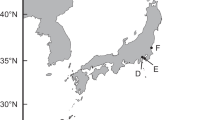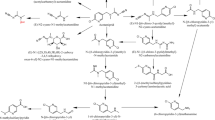Abstract
The effect of the Xymedon conjugate with methionine on blastema regeneration in Schmidtea mediterranea planarians was investigated. It was established that the preparation has low toxicity towards planarians, which is evidenced by its CL50 values (lethal concentration). The results of the vital computer morphometry and flow cytofluorometry confirm that Xymedon with methionine induces regeneration at high concentrations only: 0.01 g/100 mL, 0.05 g/100 mL, and 0.1 mg/100 mL. Low concentrations of the preparation have no influence on blastema regeneration in planarians.





Similar content being viewed by others
References
Izmailov, S. G., Izmajlov, G. A., Aver’yanov, M. Y., & Reznik, V. S. (2001). Xymedon in clinical practice. Nizhny Novgorod: NGMA.
Vyshtakaliuk, A. B., Nazarov, N. G., Porfiriev, A. G., Zueva, I. V., Minnechanova, O. A., Mayatina, O. V., Reznik, V. S., Zobov, V. V., & Nicolskyi, E. E. (2015). The influence of the Xymedon preparation (Hydroxyethyldimethyldihydropyrimidine) on the rat liver recovery under toxic damage induced by carbon tetrachloride. Dokl Biochem Biophys, 462(1), 143–146. https://doi.org/10.1134/S1607672915030011.
Vyshtakaliuk, A. B., Semenov, V. E., Zobov, V. V., Galyametdinova, I. V., Gumarova, L. F., Parfenov, A. A., Nazarov, N. G., Lenina, O. A., Kondrashova, S. A., Latypov, S. K., Cherepnev, G. V., Shashin, M. S., & Nazarov, N. G. (2017). Synthesis and primary evaluation of the hepatoprotective properties of novel pyrimidine derivatives. Russian Journal of Bioorganic Chemistry, 43(5), 604–611. https://doi.org/10.1134/S106816201704015X.
Porfiriev, A. G., Yuganova, K. S., Vyshtakaliuk, A. B., Zobov, V. V., & Reznik, V. S. (2017). The influence of the Xymedon preparation on the regeneration of Girardia tigrina planarians. BioNanoScience, 7(1), 237–239. https://doi.org/10.1007/s12668-016-0311-0.
Povysheva, T. V., Semenov, V. E., Galyametdinova, I. V., ReznikVS, K. K. S., Kolesnikov, P. E., & Chelyshev, Y. A. (2016). New Xymedon analogues for stimulation of posttraumatic regeneration of the spinal cord in rats. Bull Exp Biol Med, 162(2), 220–224. https://doi.org/10.1007/s10517-016-3580-2.
Vyshtakalyuk, A., Parfenov, A., Gumarova, L., Nazarov, N., Zobov, V., Galyametdinova, I., & Semenov, V. (2017). Comparative evaluation of hepatoprotective activity of Xymedon preparation derivatives with ascorbic acid and methionine. BioNanoScience, 7(4), 616–622. https://doi.org/10.1007/s12668-017-0461-8.
Alvarado, S. A., Newmark, P. A., Robb, S. M., & Juste, R. (2002). The Schmidtea mediterranea database as a molecular resource for studying platyhelminthes, stem cells and regeneration. Development, 129, 5659–5665. https://doi.org/10.1242/dev.00167.
Yermakova, O. N., Yermakov, A. M., Tiras, K. P., & Lednev, V. V. (2009). Melatonin effect on the regeneration of the flatworm Girardia tigrina. Russ J Dev Biol, 40(6), 382–385. https://doi.org/10.1134/S1062360409060083.
Tiras, K. P. (1986). Morphogenesis and ways of regeneration in planarians. Zh Obshch Biol, 47(1), 103–109.
Kutsenko, S. A. (2004). Bases of toxicology. Foliant: St. Petersburg.
Rombke, J., & Moltmann, J. F. (1996). Applied ecotoxicology. CRC Lewis Publishers.
Funding
The authors gratefully acknowledge for financial support from the government assignment for Federal Research Center “Kazan Scientific Center of the Russian Academy of Sciences.”
Author information
Authors and Affiliations
Contributions
Equal contribution.
Corresponding author
Ethics declarations
Conflict of Interest
The authors declare that they have no conflict of interest.
Ethics Approval
Schmidtea mediterranea planarians are well-known objects for the study of regeneration in the world. The formation of the blastema is always reached by cutting off the edges of the planarian body. Blastema formation occurs due to migration and division of neoblasts—pluripotent cells. Planarians have a very simple nervous system and do not have the sensitivity like mammals. All planarians used in the experiment survived and restored their front ends with eyes.
Consent to Participate
All authors agree to participate in this investigation.
Consent for Publication
All authors agree to participate in this article.
Code Availability
Not applicable.
Additional information
Publisher’s Note
Springer Nature remains neutral with regard to jurisdictional claims in published maps and institutional affiliations.
Rights and permissions
About this article
Cite this article
Porfiriev, A., Sharafutdinova, D., Belyaev, A. et al. The Influence of the Xymedon Сonjugate with l-Methionine on the Regeneration of Schmidtea mediterranea Planarians. BioNanoSci. 10, 397–402 (2020). https://doi.org/10.1007/s12668-020-00735-z
Published:
Issue Date:
DOI: https://doi.org/10.1007/s12668-020-00735-z




